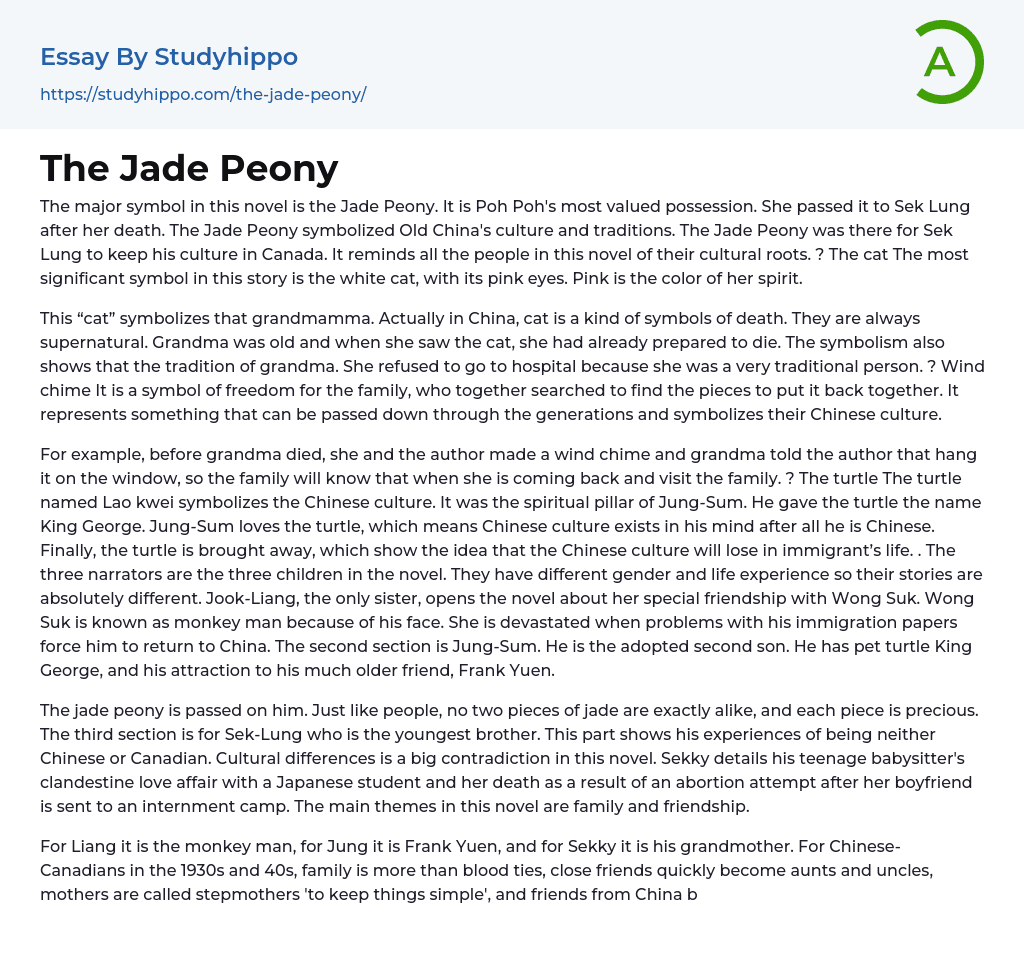The major symbol in this novel is the Jade Peony. It is Poh Poh's most valued possession. She passed it to Sek Lung after her death. The Jade Peony symbolized Old China's culture and traditions. The Jade Peony was there for Sek Lung to keep his culture in Canada. It reminds all the people in this novel of their cultural roots. ? The cat The most significant symbol in this story is the white cat, with its pink eyes. Pink is the color of her spirit.
This “cat” symbolizes that grandmamma. Actually in China, cat is a kind of symbols of death. They are always supernatural. Grandma was old and when she saw the cat, she had already prepared to die. The symbolism also shows that the tradition of grandma. She refused to go to ho
...spital because she was a very traditional person. ? Wind chime It is a symbol of freedom for the family, who together searched to find the pieces to put it back together. It represents something that can be passed down through the generations and symbolizes their Chinese culture.
For example, before grandma died, she and the author made a wind chime and grandma told the author that hang it on the window, so the family will know that when she is coming back and visit the family. ? The turtle The turtle named Lao kwei symbolizes the Chinese culture. It was the spiritual pillar of Jung-Sum. He gave the turtle the name King George. Jung-Sum loves the turtle, which means Chinese culture exists in his mind after all he is Chinese. Finally, the turtle is brough
away, which show the idea that the Chinese culture will lose in immigrant’s life. . The three narrators are the three children in the novel. They have different gender and life experience so their stories are absolutely different. Jook-Liang, the only sister, opens the novel about her special friendship with Wong Suk. Wong Suk is known as monkey man because of his face. She is devastated when problems with his immigration papers force him to return to China. The second section is Jung-Sum. He is the adopted second son. He has pet turtle King George, and his attraction to his much older friend, Frank Yuen.
The jade peony is passed on him. Just like people, no two pieces of jade are exactly alike, and each piece is precious. The third section is for Sek-Lung who is the youngest brother. This part shows his experiences of being neither Chinese or Canadian. Cultural differences is a big contradiction in this novel. Sekky details his teenage babysitter's clandestine love affair with a Japanese student and her death as a result of an abortion attempt after her boyfriend is sent to an internment camp. The main themes in this novel are family and friendship.
For Liang it is the monkey man, for Jung it is Frank Yuen, and for Sekky it is his grandmother. For Chinese-Canadians in the 1930s and 40s, family is more than blood ties, close friends quickly become aunts and uncles, mothers are called stepmothers 'to keep things simple', and friends from China become paper aunt and uncles in order to secure their entrance into Gold Mountain. For Shirley Temple, we can see that
Liang is more influenced by North American celebrities and less by the traditional Chinese influences.
When Poh-Poh refuses to watch Liang, it shows how she looks away from the modern. There is the representation of Poh-Poh’s traditional way. 8. These people live in China town so that they can still experience Chinese culture. When the other family members saw their grandma went to pickup garbages, they felt embarrassing. Another external conflict in this story is the conflict between the author which was the youngest child in the family and his sisters and brothers.
The author was following grandma all the time and he was on her side. It can also be seen as a foreshowing that tells reader that the author was influenced by grandma’s tradition. Internal conflict was also introduced in this story. Father knew that it was not good for grandma to pick up garbage, but he did not stop her and his youngest son. Because grandma was the oldest person in the family and he wanted his son to protect the grandma.
- Child essays
- Childcare essays
- Child labor essays
- Doll essays
- Academia essays
- Higher Education essays
- Language Learning essays
- Studying Business essays
- Education System essays
- Study essays
- First Day of School essays
- Scholarship essays
- Pedagogy essays
- Curriculum essays
- Coursework essays
- Studying Abroad essays
- Philosophy of Education essays
- Purpose of Education essays
- Brainstorming essays
- Educational Goals essays
- Importance Of College Education essays
- Brown V Board of Education essays
- The Importance Of Higher Education essays
- Online Education Vs Traditional Education essays
- Academic And Career Goals essays
- Academic Integrity essays
- Brown Vs Board Of Education essays
- Distance learning essays
- Technology in Education essays
- Vocabulary essays
- Writing Experience essays
- Importance of Education essays
- Early Childhood Education essays
- Academic Degree essays
- Academic Dishonesty essays
- School Uniform essays
- Academic writing essays
- Cheating essays
- Bachelor's Degree essays
- MBA essays
- College Life essays
- Grade essays
- Diploma essays
- Phonology essays
- Sentence essays
- Filipino Language essays
- Pragmatics essays
- Millennium Development Goals essays
- History Of Education essays
- Graduate School essays




